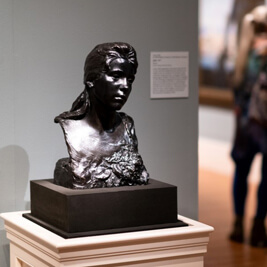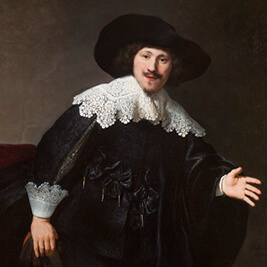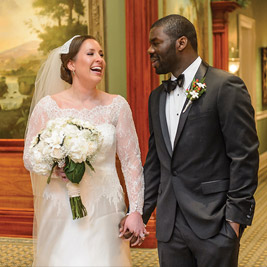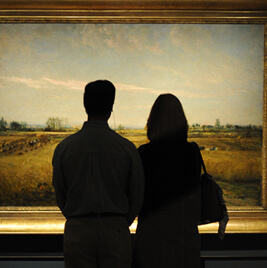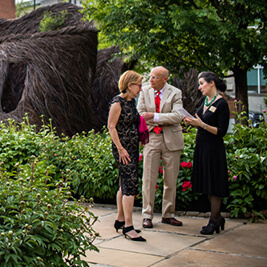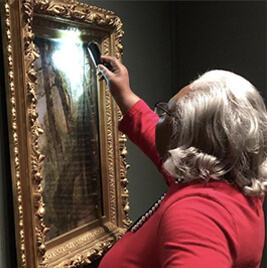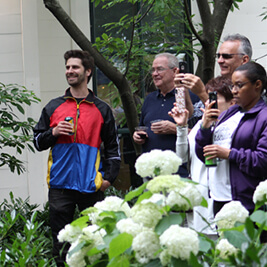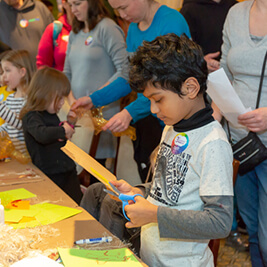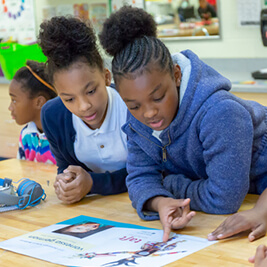- Do + See
- Dine + Host
- Give + Join
- Educate + Learn
Highlights from the Taft Collection | Summer 2021
A Closer Look
Discover these works from the Taft Museum of Art collection and more in the upcoming bicentennial exhibition In a New Light.
Monvaerni Master, Triptych with the Crucifixion, Saint James, and Saint Catherine of Alexandria
This somber scene of Christ’s execution provided a focal point for devotion in the private chapel of a pious 15th-century Christian. The owner could fold the hinged panels of this three-part altarpiece—called a triptych—for easy storage and transport. Saint James, dressed as a pilgrim, appears on the left panel, and Saint Catherine, on the right, holds the sword that beheaded her. On the blade, a puzzling inscription, “MONVAE[?]NI,” previously believed to be the artist’s signature, probably instead refers to the patron of the triptych’s artist.
TAKE A CLOSER LOOK
Imagine using this triptych in your spiritual practice. Where would your eye naturally fall? How does that part of the composition make you feel?
Frank Duveneck, An Italian Woman
A woman gazes boldly at us, her chin slightly lifted, her dark hair parted down the middle. Light hits the right side of her face, leaving the left in shadow. When Covington, Kentucky-born artist Frank Duveneck was teaching in Florence, Italy, he hired local peasants to serve as models. In this oil study, Duveneck loosely applied paint to suggest the woman’s collar, earrings, and necklace, as well as the background, then carefully modeled her facial features.
TAKE A CLOSER LOOK
Imagine going on vacation and forgetting your camera at home. How would you capture your favorite moments during your travels?
Notice the expressive brushstrokes in this painting. Not only do they capture the woman’s likeness, but also a sense of emotion. How do you think the artist felt when he painted this portrait? What might this woman be feeling as the artist was painting her?
Balthasar van der Ast, Still Life with Tilted Basket of Fruit, Vase of Flowers, and Shells
Balthasar van der Ast’s elaborate still life includes 32 different flowers, eleven kinds of shells, eight types of fruit, five insects and spiders, two lizards, and a parrot. This arrangement could never have existed in reality: the painting combines blooms from different seasons. These specimens served as reminders of mortality. The cut flowers will quickly wilt. The empty shells once protected living creatures. The butterfly has left behind its earthbound caterpillar body, suggesting the resurrection of Christ. Van der Ast’s imagined assemblage celebrates nature’s bounty while cautioning viewers to lead lives headed toward heaven.
TAKE A CLOSER LOOK
For thirty seconds, look closely at this painting. What details do you notice? What different kinds of flowers are in the vase? What insects do you see?
This still life painting holds so many details that it is difficult to see them all the first time you look at it. Return to the painting in a couple of days. Do you notice anything new?
China, Qing dynasty, Qianlong reign, Basin with the Goddess Xiwangmu
The ancient Chinese goddess Xiwangmu, Queen Mother of the West, rides a blue phoenix at upper left. Directly above her, on the basin’s lip, appears a pair of peaches. According to Daoist tradition, Xiwangmu cultivated in her garden a magic peach tree, the fruit of which ripened only once every six thousand years. At harvest time, Xiwangmu hosted a party for the immortals, and all consumed this special fruit, supernaturally extending their lifespans. Peaches therefore represent the average person’s desire for a long life.
TAKE A CLOSER LOOK
Notice how the bright colors and swirling lines make the figures on this enamel basin come to life. Even if you are unfamiliar with the story depicted on this object, use clues to decode what is happening.
Who do you think is the most important person in this story? Where is the story taking place?
Explore More Highlights from Our Eleven Inspiring Rooms
The Taft Museum of Art is home to an extensive art collection that includes European and American master paintings and sculptures, and 17th-19th century European watches, Chinese porcelains, French Renaissance enamels, and 19th-century American furniture. Learn more today!

